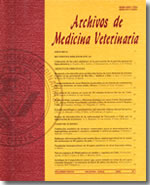Insulin sensitivity in prepubertal growing ewes with normal and restricted alimentation
Main Article Content
Abstract
It has been shown that fasting in growing ewes is associated with insulin resistance as an adaptative mechanism to the low energy supply. Food restriction is another experimental or natural situation that may occur for growing ewes where energy supply is under the requirement for growth. Insulin sensitivity may also change as a physiological adaptation to the shortage of food. The aim of the present study was to assess if insulin sensitivity decreases during food restriction in growing ewes. Insulin sensitivity was assessed by the intravenous glucose tolerance test (IVGTT). A glucose solution (300mg/kg body weight, 50% solution) was infused over two minutes into five normal growing 26-week old ewes and five 26 week-old ewes that had been restrictively fed from the age of 20 to 26 weeks. Blood samples were collected from the jugular vein of each ewe by an indwelling jugular vein catheter 15 and 10 min before and at 0, 3, 5, 7, 10, 13, 15, 17, 20, 23, 25, 27 and 30 min after the initiation of the glucose infusion, and plasma glucose and insulin were measured by RIA. To determine the insulin sensitivity index (ISI), glucose and insulin concentrations were analyzed using the Matsuda and De Fronzo's formula (ISI-Composite). Basal, stimulated and incremental area under the curve of insulin and the glucose utilization constants were also calculated. ISI-C was lower in food-restricted female sheep (636.43 ± 125.66) compared to normal growing females (1528.18 ± 297.61), (P < 0.05). Concordant with this, incremental area under the curve of insulin was lower (290.54 ± 79.45 ng/ml/30 min) in control than in food-restricted females (642.16 ± 140.04 ng/mL/30 min, P < 0.05). The glucose utilization constant did not differ between groups. Results suggest that food restriction induces insulin resistance as an adaptative process to the shortage of food in growing female sheep.

